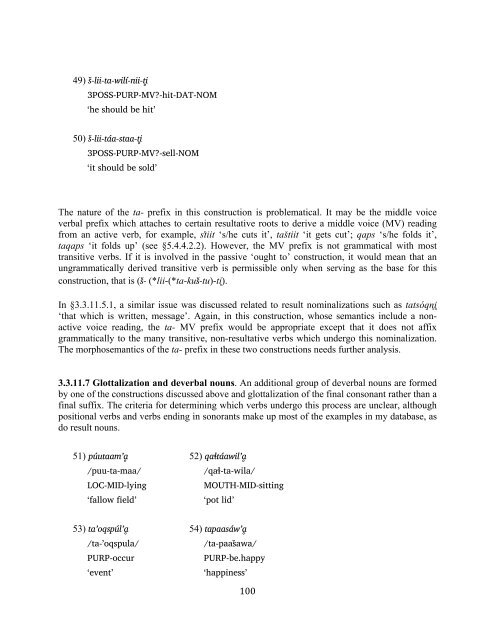The phonology and morphology of Filomeno Mata Totonac
The phonology and morphology of Filomeno Mata Totonac
The phonology and morphology of Filomeno Mata Totonac
You also want an ePaper? Increase the reach of your titles
YUMPU automatically turns print PDFs into web optimized ePapers that Google loves.
49) s%-lii-ta-wilí-nii-ti&<br />
3POSS-PURP-MV?-hit-DAT-NOM<br />
‘he should be hit’<br />
50) s%-lii-táa-staa-ti&<br />
3POSS-PURP-MV?-sell-NOM<br />
‘it should be sold’<br />
<strong>The</strong> nature <strong>of</strong> the ta- prefix in this construction is problematical. It may be the middle voice<br />
verbal prefix which attaches to certain resultative roots to derive a middle voice (MV) reading<br />
from an active verb, for example, s'tiit ‘s/he cuts it’, ta#tiit ‘it gets cut’; qaps ‘s/he folds it’,<br />
taqaps ‘it folds up’ (see §5.4.4.2.2). However, the MV prefix is not grammatical with most<br />
transitive verbs. If it is involved in the passive ‘ought to’ construction, it would mean that an<br />
ungrammatically derived transitive verb is permissible only when serving as the base for this<br />
construction, that is (s%- (*lii-(*ta-kus%-tu)-ti").<br />
In §3.3.11.5.1, a similar issue was discussed related to result nominalizations such as tatsóqn"i"<br />
‘that which is written, message’. Again, in this construction, whose semantics include a nonactive<br />
voice reading, the ta- MV prefix would be appropriate except that it does not affix<br />
grammatically to the many transitive, non-resultative verbs which undergo this nominalization.<br />
<strong>The</strong> morphosemantics <strong>of</strong> the ta- prefix in these two constructions needs further analysis.<br />
3.3.11.7 Glottalization <strong>and</strong> deverbal nouns. An additional group <strong>of</strong> deverbal nouns are formed<br />
by one <strong>of</strong> the constructions discussed above <strong>and</strong> glottalization <strong>of</strong> the final consonant rather than a<br />
final suffix. <strong>The</strong> criteria for determining which verbs undergo this process are unclear, although<br />
positional verbs <strong>and</strong> verbs ending in sonorants make up most <strong>of</strong> the examples in my database, as<br />
do result nouns.<br />
51) púutaam’a& 52) qa"táawil’a&<br />
/puu-ta-maa/ /qa#-ta-wila/<br />
LOC-MID-lying MOUTH-MID-sitting<br />
‘fallow field’ ‘pot lid’<br />
53) ta’oqspúl’a& 54) tapaasáw’a&<br />
/ta-'oqspula/ /ta-paas"awa/<br />
PURP-occur PURP-be.happy<br />
‘event’ ‘happiness’<br />
! "..!

















